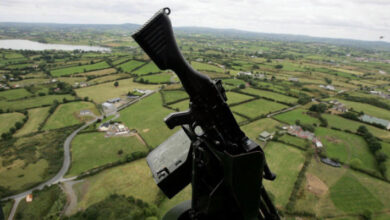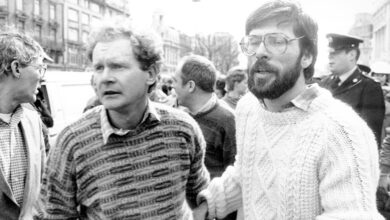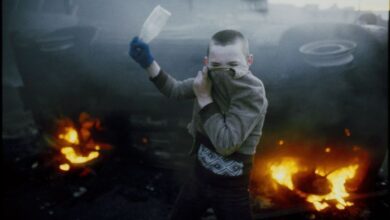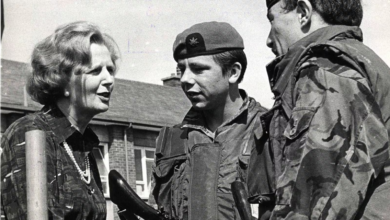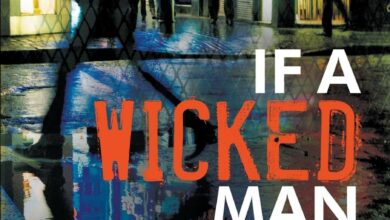No Myths for These Countries of the Mind
by Martina Buckley
A reflection about contemporary post-human society according to William Gibson
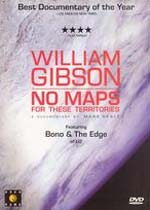 Any time I watch No Maps for These Territories it’s a mesmerising experience. The documentary is a pre-9/11 long interview with William Gibson. He sits in the back of a limo, smoking cigarettes and slowly speaking in his reassuring Canadian drawl about what is like to be him, the symbol-writer of a generation of post-punk young readers.
Any time I watch No Maps for These Territories it’s a mesmerising experience. The documentary is a pre-9/11 long interview with William Gibson. He sits in the back of a limo, smoking cigarettes and slowly speaking in his reassuring Canadian drawl about what is like to be him, the symbol-writer of a generation of post-punk young readers.
Gibson is relaxed when he talks, convinced and convincing. While he goes through the narrative of his life you realise how different he is from his fiction, you realise he’s not Case or Turner and yet his extraordinary creativeness catches the listener in a net of reverential respect. He is almost embarrassed by the cyberpunk label attached to the Sprawl trilogy, but obviously proud of his perception of a new possible reality, which he put on paper with the new name of cyberspace. Now, more than 25 years later, cyberspace is everywhere.
The consensual hallucination so well narrated in Neuromancer is now far from being sci-fi. It is our contemporary post-modern society or, á la Gibson, post-human.
 William Gibson was born in 1948 in the States where he lived until his college days (he then moved to Canada). He lived through the sixties and seventies, through the drug and sex revolution, the Vietnam War protest and through the death of his role model, William Burroughs. He calls Burroughs a “real master” and there we get to know where the visionary world of his writings comes from.
William Gibson was born in 1948 in the States where he lived until his college days (he then moved to Canada). He lived through the sixties and seventies, through the drug and sex revolution, the Vietnam War protest and through the death of his role model, William Burroughs. He calls Burroughs a “real master” and there we get to know where the visionary world of his writings comes from.
He does not look like somebody who lived his teens in a psychedelic drug-enhanced culture. He is polite and softly spoken, his hair neatly styled, his glasses thick and conventional, his blue shirt almost anonymous. Yet, his cultural background pervades everywhere in his Sprawl trilogy. That’s where he got his Cyberpunk stamp.
However, his writings go well beyond sex, drugs and rock’n’roll. His novels are a lucid, disturbing vision of a dystopian future that too much resembles our contemporary mediated society. Gibson uses continuously this term, mediated, filtered and interpreted by media. This is how humans become post-humans: they become mediated, co-opted by technology.
Stealing once more Gibson’s wonderful vocabulary, our life becomes post-geographical, spread in new virtual territories that extend beyond language and physicality. Cyber-territories without maps, part of our prosthetic-extended nervous system. The Internet. The net connected us all, willingly or not. It’s not a mere free encyclopaedia, a quick useful reference html. It’s us, our extended brain, our new language and methodology of communication. We are overcoming verbalism to confront lines of text instead, jacked into the still unexplored cyber-territories.
Non-mediated human beings do not exist any longer. Homo sapiens stepped onto a new evolutionary level. Our anatomy did not change much from our cave-dwelling ancestors, but our brain seems to have acquired the extraordinary capability of transcending the physicality of the pre-technological worlds. We barely walk anymore. If we need to go anywhere, we jack in, turn on our virtual realities and move in those uncharted territories, where places are no-places.
 Gibson is almost nostalgic of the pre-cyber society. There is a sense of loss, he says, a sense of surprise at the same time. It is like a peak experience of the contemporary, a sort of epiphany that induces a sense of terror and pain. The lack of proximal social structure, the extended family, the tribe, the village, launched the mediated humans towards new realities in order to compensate the emptiness, the anomie. We are a dysphoric species that can choose between Prozac and Cyberspace in order to find a meaning. Or both. Gibson asks himself if Cyberspace is a substitute for drugs, a mean to resolve the isolation of the post-modern human. The same isolation that pushed Gibson towards writing and creativity. He is convinced that he went through a period of madness when he was young. His creativity spawned from this madness. Once again we confront the equation mental disorder=genius that characterizes the history of human creativity.
Gibson is almost nostalgic of the pre-cyber society. There is a sense of loss, he says, a sense of surprise at the same time. It is like a peak experience of the contemporary, a sort of epiphany that induces a sense of terror and pain. The lack of proximal social structure, the extended family, the tribe, the village, launched the mediated humans towards new realities in order to compensate the emptiness, the anomie. We are a dysphoric species that can choose between Prozac and Cyberspace in order to find a meaning. Or both. Gibson asks himself if Cyberspace is a substitute for drugs, a mean to resolve the isolation of the post-modern human. The same isolation that pushed Gibson towards writing and creativity. He is convinced that he went through a period of madness when he was young. His creativity spawned from this madness. Once again we confront the equation mental disorder=genius that characterizes the history of human creativity.
Gibson starts telling us about how he desperately wanted to be a writer and how the creative process of writing is similar to the process of daydreaming, fantasy and anxiety.
From this definition, we discover the real essence of his art. He is a visionary who lives in “an incomprehensible present” that scares and obsesses him. He writes in the moment he lives in, without planning or drafting. His books happen because he writes them, the characters becoming in control of the process of writing. Writing, for Gibson, is a dialogical process: readers are in control of the book as much as the writer. They read it, interpret it, and mediate it. Reading is a creative process.
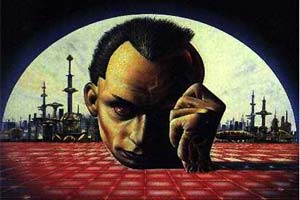 Gibson still sits in the back of the limo deconstructing himself and the reality around him. A reality that it is not possible any longer to frame within physical boundaries. The film is almost at the end. For a moment I, the reader, almost see Case sitting beside him, his Ono-Sendai on his lap, jacked in the matrix, inside the consensual hallucination that we all well know. And yet I know Case is not there, even though he’s everywhere, not only in the tangled prose of the Neuromancer, not only in Gibson’s visionary world. I know because I’ll jack in too later and I’ll ride the alternative reality that we all constructed in the ultimate effort to overcome our loneliness. Our ultimate effort to resolve our sense of loss caused by the disappearance of non-mediated values. We call it Internet, or Cyberspace, as Gibson dreamed decades ago. It’s a no-place, but very real nevertheless.
Gibson still sits in the back of the limo deconstructing himself and the reality around him. A reality that it is not possible any longer to frame within physical boundaries. The film is almost at the end. For a moment I, the reader, almost see Case sitting beside him, his Ono-Sendai on his lap, jacked in the matrix, inside the consensual hallucination that we all well know. And yet I know Case is not there, even though he’s everywhere, not only in the tangled prose of the Neuromancer, not only in Gibson’s visionary world. I know because I’ll jack in too later and I’ll ride the alternative reality that we all constructed in the ultimate effort to overcome our loneliness. Our ultimate effort to resolve our sense of loss caused by the disappearance of non-mediated values. We call it Internet, or Cyberspace, as Gibson dreamed decades ago. It’s a no-place, but very real nevertheless.
It’s all there, in his books.
AGRIPPA (A Book of The Dead)
Text by William Gibson
Etchings by Dennis Ashbaugh
©1992 Kevin Begos Publishing
1411 York Ave. New York, NY
All Rights Reserved
I hesitated
before untying the bow
that bound this book together.A black book:
ALBUMS
CA. AGRIPPA
Order Extra Leaves
By Letter and NameA Kodak album of time-burned
black construction paperThe string he tied
Has been unravelled by years
and the dry weather of trunks
Like a lady’s shoestring from the First World War
Its metal ferrules eaten by oxygen
Until they resemble cigarette-ashInside the cover he inscribed something in soft graphite
Now lost
Then his name
W.F. Gibson Jr.
and something, comma,
1924Then he glued his Kodak prints down
And wrote under them
In chalk-like white pencil:
“Papa’s saw mill, Aug. 1919.”A flat-roofed shack
Against a mountain ridge
In the foreground are tumbled boards and offcuts
He must have smelled the pitch, In August
The sweet hot reek
Of the electric saw
Biting into decadesNext the spaniel Moko
“Moko 1919”
Poses on small bench or table
Before a backyard tree
His coat is lustrous
The grass needs cutting
Beyond the tree,
In eerie Kodak clarity,
Are the summer backstairs of Wheeling,
West Virginia
Someone’s left a wooden stepladder out“Aunt Fran and [obscured]”
Although he isn’t, this gent
He has a “G” belt-buckle
A lapel-device of Masonic origin
A patent propelling-pencil
A fountain-pen
And the flowers they pose behind so solidly
Are rooted in an upright length of whitewashed
concrete sewer-pipe.Daddy had a horse named Dixie
“Ford on Dixie 1917”
A saddle-blanket marked with a single star
Corduroy jodpurs
A western saddle
And a cloth cap
Proud and happy
As any boy could be“Arthur and Ford fishing 1919”
Shot by an adult
(Witness the steady hand
that captures the wildflowers
the shadows on their broad straw hats
reflections of a split-rail fence)
standing opposite them,
on the far side of the pond,
amid the snake-doctors and the mud,
Kodak in hand,
Ford Sr.?And “Moma July, 1919”
strolls beside the pond,
in white big city shoes,
Purse tucked behind her,
While either Ford or Arthur, still straw-hatted,
approaches a canvas-topped touring car.“Moma and Mrs. Graham at fish hatchery 1919”
Moma and Mrs. G. sit atop a graceful concrete
arch.“Arthur on Dixie”, likewise 1919,
rather ill at ease.
On the roof behind the barn, behind him,
can be made out this cryptic mark:
H.V.J.M.[?]“Papa’s Mill 1919”, my grandfather most regal amid a wrack of
cut lumber,
might as easily be the record
of some later demolition, and
His cotton sleeves are rolled
to but not past the elbow,
striped, with a white neckband
for the attachment of a collar.
Behind him stands a cone of sawdust some thirty feet in height.
(How that feels to tumble down,
or smells when it is wet)II.
The mechanism: stamped black tin,
Leatherette over cardboard, bits of boxwood,
A lens
The shutter falls
Forever
Dividing that from this.Now in high-ceiling bedrooms,
unoccupied, unvisited,
in the bottom drawers of veneered bureaus
in cool chemical darkness curl commemorative
montages of the country’s World War dead,just as I myself discovered
one other summer in an attic trunk,
and beneath that every boy’s best treasure
of tarnished actual ammunition
real little bits of war
but also
the mechanism
itself.The blued finish of firearms
is a process, controlled, derived from common
rust, but there
under so rare and uncommon a patina
that many years untouched
until I took it up
and turning, entranced, down the unpainted
stair,
to the hallway where I swear
I never heard the first shot.The copper-jacketed slug recovered
from the bathroom’s cardboard cylinder of
Morton’s Salt
was undeformed
save for the faint bright marks of lands
and grooves
so hot, stilled energy,
it blistered my hand.The gun lay on the dusty carpet.
Returning in utter awe I took it so carefully up
That the second shot, equally unintended,
notched the hardwood bannister and brought
a strange bright smell of ancient sap to life
in a beam of dusty sunlight.
Absolutely alone
in awareness of the mechanism.Like the first time you put your mouth
on a woman.III.
“Ice Gorge at Wheeling
1917”Iron bridge in the distance,
Beyond it a city.
Hotels where pimps went about their business
on the sidewalks of a lost world.
But the foreground is in focus,
this corner of carpenter’s Gothic,
these backyards running down to the freeze.“Steamboat on Ohio River”,
its smoke foul and dark,
its year unknown,
beyond it the far bank
overgrown with factories.“Our Wytheville
House Sept. 1921”They have moved down from Wheeling and my father wears his
city clothes. Main Street is unpaved and an electric streetlamp is
slung high in the frame, centered above the tracked dust on a
slack wire, suggesting the way it might pitch in a strong wind,
the shadows that might throw.The house is heavy, unattractive, sheathed in stucco, not native
to the region. My grandfather, who sold supplies to contractors,
was prone to modern materials, which he used with
wholesaler’s enthusiasm. In 1921 he replaced the section of brick
sidewalk in front of his house with the broad smooth slab of poured
concrete, signing this improvement with a flourish, “W.F. Gibson 1921”. He believed in concrete and plywood
particularly. Seventy years later his signature remains, the slab
floating perfectly level and charmless between mossy stretches of
sweet uneven brick that knew the iron shoes of Yankee horses.“Mama Jan. 1922” has come out to sweep the concrete with a
broom. Her boots are fastened with buttons requiring a special instrument.Ice gorge again, the Ohio, 1917. The mechanism closes. A
torn clipping offers a 1957 DeSOTO FIREDOME, 4-door Sedan,
torqueflite radio, heater and power steering and brakes, new
w.s.w. premium tires. One owner. $1,595.IV.
He made it to the age of torqueflite radio
but not much past that, and never in that town.
That was mine to know, Main Street lined with
Rocket Eighty-eights,
the dimestore floored with wooden planks
pies under plastic in the Soda Shop,
and the mystery untold, the other thing,
sensed in the creaking of a sign after midnight
when nobody else was there.In the talc-fine dust beneath the platform of the
Norfolk & Western
lay indian-head pennies undisturbed since
the dawn of man.In the banks and courthouse, a fossil time
prevailed, limestone centuries.When I went up to Toronto
in the draft,
my Local Board was there on Main Street,
above a store that bought and sold pistols.
I’d once traded that man a derringer for a
Walther P-38.
The pistols were in the window
behind an amber roller-blind
like sunglasses.
I was seventeen or so but basically I guess
you just had to be a white boy.
I’d hike out to a shale pit and run
ten dollars worth of 9mm
through it, so worn you hardly
had to pull the trigger.
Bored, tried shooting
down into a distant stream but
one of them came back at me
off a round of river rock
clipping walnut twigs from a branch
two feet above my head.
So that I remembered the mechanism.V.
In the all night bus station
they sold scrambled eggs to state troopers
the long skinny clasp-knives called fruit knives
which were pearl handled watermelon-slicers
and hillbilly novelties in brown varnished wood
which were made in Japan.First I’d be sent there at night only
if Mom’s carton of Camels ran out,
but gradually I came to value
the submarine light, the alien reek
of the long human haul, the strangers
straight down from Port Authority
headed for Nashville, Memphis, Miami.
Sometimes the Sheriff watched them get off
making sure they got back on.When the colored restroom
was no longer required
they knocked open the cinderblock
and extended the magazine rack
to new dimensions,
a cool fluorescent cave of dreams
smelling faintly and forever of disinfectant,
perhaps as well of the travelled fears
of those dark uncounted others who,
moving as though contours of hot iron,
were made thus to dance
or not to dance
as the law saw fit.There it was that I was marked out as a writer,
having discovered in that alcove
copies of certain magazines
esoteric and precious, and, yes,
I knew then, knew utterly,
the deal done in my heart forever,
though how I knew not,
nor ever have.Walking home
through all the streets unmoving
so quiet I could hear the timers of the traffic lights a block away:
the mechanism.
Nobody else, just the silence
spreading out
to where the long trucks groaned
on the highway
their vast brute souls in want.VI.
There must have been a true last time
I saw the station but I don’t remember
I remember the stiff black horsehide coat
gift in Tucson of a kid named Natkin
I remember the cold
I remember the Army duffle
that was lost and the black man in Buffalo
trying to sell me a fine diamond ring,
and in the coffee shop in Washington
I’d eavesdropped on a man wearing a black tie
embroidered with red roses
that I have looked for ever since.They must have asked me something
at the border
I was admitted
somehow
and behind me swung the stamped tin shutter
across the very sky
and I went free
to find myself
mazed in Victorian brick
amid sweet tea with milk
and smoke from a cigarette called a Black Cat
and every unknown brand of chocolate
and girls with blunt-cut bangs
not even Americans
looking down from high narrow windows
on the melting snow
of the city undreamed
and on the revealed grace
of the mechanism,
no round trip.They tore down the bus station
there’s chainlink there
no buses stop at all
and I’m walking through Chiyoda-ku
in a typhoon
the fine rain horizontal
umbrella everted in the storm’s Pacific breath
tonight red lanterns are battered,laughing,
in the mechanism.


